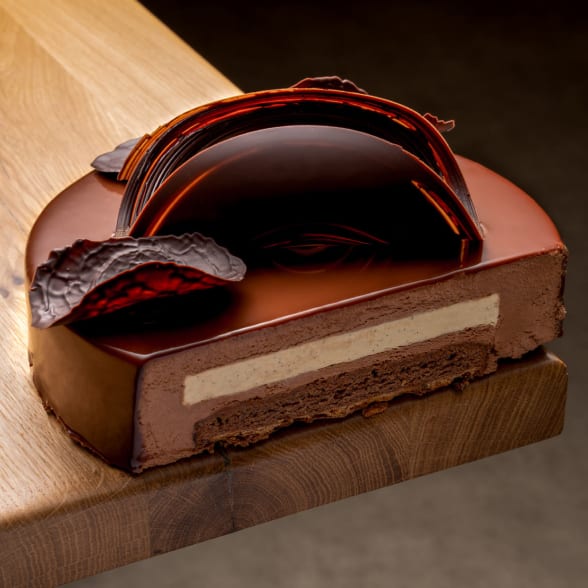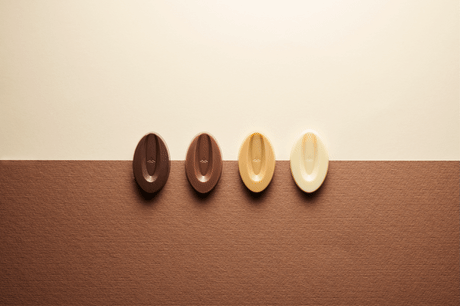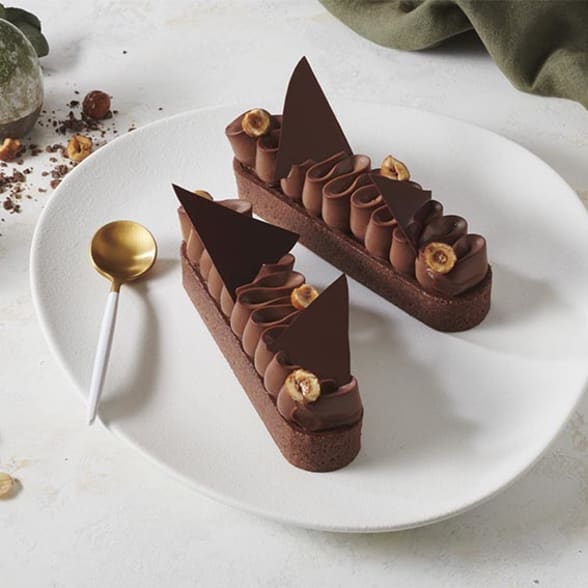
Professional Recipes
Our iconic creations will allow you to renew your offer by revisiting the great classics of pastry-making but also by offering you inspiring recipes to work with the raw material that is chocolate.
Contents :
Chocolate has many types. It can be classified into different categories depending on its color, composition, uses, flavor potential, price and so on. Keep reading to explore the different types of chocolate.
The term “chocolate” is regulated by law. For a food to be called chocolate, it must have a minimum cocoa content of 35%. The European Cocoa/Chocolate Directive 2000-36-EC sets out expectations for chocolate’s composition.
An emulsifier can be added to it to make it fluid. At Valrhona, we use sunflower lecithin, which is a very common binder found in many foods.
In addition, legislation allows for up to 5% vegetable fat other than cocoa butter to be added to the recipe. Only mango kernel oil, palm oil, shea butter, illipe butter, kokum oil and shorea robusta seed oil are allowed.
At Valrhona, recipes are developed after 1 to 2 years of research by R&D engineers with the help of our sensory analysis panel. Today, we make more than 100 different chocolate dark, white, blond or milk. Together, let’s discover chocolate’s different categories by color.

Dark chocolate has an intense, profound taste thanks to its high cocoa content. It is made of cocoa butter, cocoa paste (or “cocoa mass”) and sugar.
For a dark chocolate to be described as “fine” or “superior”, legislation requires a cocoa concentration of at least 43%, with 26% cocoa butter and 14% cocoa. Dark chocolate’s aromas are highly influenced by its cocoa’s terroir. The bitter, intense and deep taste that sometimes comes with this designation of chocolate is sought after by people who love dark flavors.
Like dark chocolate, milk chocolate contains cocoa butter, cocoa paste and sugar. It differs from dark chocolate because of the powdered milk that is added to its basic ingredients.
Chocolate is a dry substance: throughout its production, we carefully reduce its humidity levels by drying, roasting and conching the beans. As a result, the ingredients we add to it should be as dry as possible.
Milk chocolate’s composition is as follows:
This type of chocolate is available as a snack or pastry-making ingredient. Its cocoa-inflected milk flavor makes it particularly useful for indulgent desserts, especially during the Christmas and Easter festivities.
Chocolate’s third color is white. This variety was invented by the famous Swiss chocolatier Daniel Peter. White chocolate’s main component is cocoa butter, a natural fat obtained from cocoa beans. This unusual composition makes it a unique kind of chocolate!
White chocolate is made of:
Cocoa butter’s flavor is usually neutralized before being used in chocolate.
White chocolate is a precious ally to pastry chefs. Cocoa butter is very good at locking onto other flavors and can be combined with a multitude of them. It is particularly widely used in macaron fillings.
With Dulcey, Valrhona invented the fourth chocolate color – Blond. During one of his cookery demonstrations, Frédéric Bau once absent-mindedly left his white chocolate in the bain-marie. He was astonished to see the chocolate had taken on a beautiful blond hue much like dulce de leche and was now emanating a delicate aroma of toasted shortbread and caramelized milk.
It would take Valrhona eight years of research and development from that moment of lucky happenstance to develop the Dulcey recipe we know today. This “blond chocolate” is therefore actually a blond-colored white chocolate! Orelys then made the perfect addition to the blond range with its biscuity notes and delicate licorice aromas.
Whatever type of chocolate shops and makers supply, it has two main roles. Chocolate can be enjoyed as it is or used as an ingredient in pastry preparations. Read on to learn more about the a few of the forms chocolates can take.
Lots of people all around the world love enjoying a piece of chocolate with a coffee, at snack-time or as a dessert.
Did you know that chocolate should be eaten at room temperature? Chocolate is stored at a temperature below 64°F (18°C) and enjoyed between 20°C and 22°C.
Chocolate bars are undoubtedly the most common form of chocolate. They are available to buy in all shops and come in all kinds of colors. However, it can be difficult to choose your chocolate bar. Quality chocolate is what to look out for in a bar, first and foremost.
Making a chocolate involves researching what cocoa percentage will bring out the end product’s finest qualities. We have to carefully establish a subtle balance that will reveal a singular aromatic profile as we bring out one or more terroirs’ unique characteristics. The aromatic power of a chocolate is linked to its cocoa’s terroir of origin, its recipe and its manufacturing process. As such, it isn’t true to say that a chocolate is automatically better if its cocoa percentage is higher.
Please click here to find out more about what your bar’s cocoa percentage means.
Bonbons are one of the most common types of chocolate confectionery out there. They can be packaged in different ways (including sachets, mixed bags and boxes).
If you’re struggling to choose between different types of chocolate, you can always look for a box of chocolates. These assortments contain all kinds of chocolate bonbons filled with ganache, liqueur, fruits and pralinés, and coated in dark, white, milk or blond chocolate.
Cooking chocolate is mainly used by pastry chefs and chocolatiers. Valrhona offers a complete range of high quality professional cooking chocolates.
Couverture chocolate is much appreciated for its fluid consistency. These chocolates are at least 32% cocoa butter. This ingredient is often added to top up the cocoa butter naturally found in beans and makes the chocolate more flexible and easier to work with. Couvertures are also a glossier kind of chocolate.
For all these reasons, couverture chocolate is ideal for coating chocolate bonbons and gateaux. Couverture is used by chocolatiers to coat their Christmas chocolates, for example, but it can also be enjoyed as a bar or a square.
Drops are small chocolate pastilles which we at Valrhona refer to as “fèves”. (The word fève is French for “bean”, although they aren’t cocoa beans themselves!) Fèves are used to make elaborate recipes. They have the advantage of melting more homogeneously than chocolate bars and do not need to be ground down. The more inpatient connoisseurs among us can also enjoy them as they are!
When ground and heated between steel cylinders, cocoa beans turn into cocoa paste. The paste is then pressed to separate out their liquid, cocoa butter and solids and form a “cake”. The cake is sifted to create a cocoa powder.
Cocoa powder is 100% pure and includes no added sugar. It is widely used to make pastries and desserts and is often found dusted on truffles.
When it is mixed with sugar, cocoa powder becomes the powdered chocolate commonly used to make hot drinks. For a Valrhona-style extra-indulgent hot chocolate, replace the powdered chocolate with chocolate shavings.
Cocoa butter is a plant-based fat made from cocoa beans. The beans are fermented, roasted and then crushed. The resulting small chips are called nibs. The nibs include cocoa butter and cocoa powder, two essential ingredients for many chocolate products.
Cocoa butter is used, among other things, to make chocolate melt more effectively and give it a glossy look and fluid texture. Once set, it also gives chocolate bars their characteristic “snap” and crunch on the palate.
Cocoa nibs are one of cocoa’s intermediate forms. They are made by crushing roasted cocoa beans. Cocoa nibs are used by chocolatiers to design intensely flavored chocolate. They can be ground into a paste or pressed to make cocoa powder.
All chocolates, dark, white or milk, can go into all kinds of cakes, biscuits, chocolate bonbons and desserts. Thanks to its cocoa flavor we all love so much and its consistency, chocolate can be used to make unique pastry creations. Here are some examples of preparations you can make using Valrhona couverture chocolate.
Ganache is made from chocolate and cream. It is used as a filling for biscuits, cakes and sweets, but can also as the perfect decorative addition to desserts.
Praliné is at least 50% nuts (almonds, hazelnuts or both) and also contains sugar. There are different ways to make it, each one of which gives the praliné a unique taste:
Praliné is a smooth paste that serves as a filling for bonbons and for making desserts such as Paris-Brest.
Coating entails covering a chocolate bonbon or any other confectionery product (such as fruit paste, for example) with chocolate. A good coating meets two criteria: It has to use quality couverture chocolate and the temperature has to be carefully controlled.
The list of forms that chocolate can take is long. As well as different colors (dark, white, milk or blond), chocolate can take all kinds of forms when it is designed to be eaten as it is, including bars, eggs, bitesize pieces, boxes of bonbons and so on.
Moreover, it is often combined with other ingredients to marry together their aromas and flavors. Chocolate blends perfectly with caramel, coffee, hazelnuts, fruit (including orange, berries, apricot, banana and pear), mint and many other ingredients.
The various chocolates available provide plenty of scope for creativity. Its inimitable taste, unique texture, malleability and appearance make chocolate an essential part of creative pastry making.

Our iconic creations will allow you to renew your offer by revisiting the great classics of pastry-making but also by offering you inspiring recipes to work with the raw material that is chocolate.

Are you a pastry lover? Let yourself be tempted by Valrhona's chocolate creations. Our detailed iconic recipes will guide you step by step through the design of your chocolate pastry.
You are using an outdated browser. Please upgrade your browser to improve your experience and security.
×